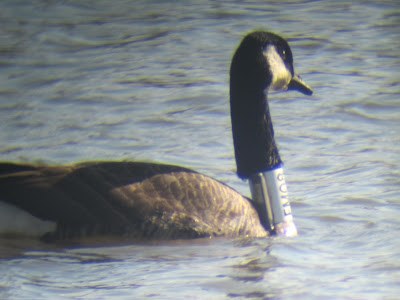This is with my 36x optical zoom. I could only see a bit better with my scope. The birds on the left are Buffleheads. The four on the right are grebes. Can you tell that one of these grebes is not like the others?
How about now?
I watched the birds for over 10 minutes, and could tell that one was clearly smaller, riding lower in the water, with a thinner neck. At times it seemed like the bird had a thinner, sharper, slightly upturned bill. And a pointing headed profile, with a peak above the eye. While the other three are chunky Horned Grebes, the smaller one is an Eared Grebe--a rarity in New Jersey.
Did I see it well enough to be sure of the identification? Or was my old scope and bad lighting and distance playing tricks on me?
After watching a bit more I couldn't make it into a Horned Grebe, so I made the call and waited for confirming backup to arrive.
The first birder on the scene could tell it was smaller, but wasn't comfortable making the call. Finally others arrived, and with perhaps better light, and less mist, everyone finally got a good enough look to confirm the ID. Whew! Nothing like putting your birding reputation on the line!
Turns out it was a fantastic day at the reservoir, with 10 Long-tailed Ducks, 6 Canvasbacks,5 Greater Scaup, over 150 Buffleheads, 6 Common Loons, and some Red-breasted Mergansers making it the heaviest waterfowl event of the season so far. The first Greater Yellowlegs of the season flew over, and later 23 Bonaparte's Gulls stopped by, and after I left apparently 29 Red-throated Loons stopped in. You've just gotta go birding in the rain when you get a storm like this.
Tom Smith got some slightly better photos of the Eared Grebe here.



































